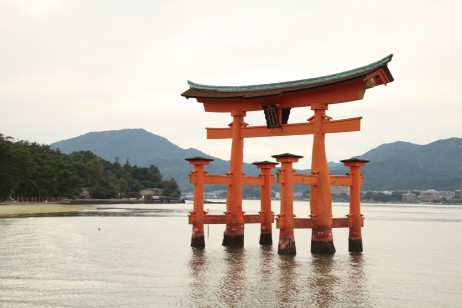 We had always planned to go to Hiroshima from early on in thinking about our time in Japan, but we had thought it would be a day trip from Kyoto. Yet something led us to wanting more time there. We imagined Hiroshima would be a somber place, but our time there was far more vibrant than we expected. The city and its rivers spread out like a beautiful fan. We visited the remarkable orange shrine rising from the water at Miyajima. We met a Scotsman named Ralph Danks, who played in bands in the sixties opening for the Beatles and the Rolling Stones, and was now a successful artist living in Tokyo, in town for an exhibition. We became fast friends with him and enjoyed two memorable meals, both in the best little sushi joint in Hiroshima. We also ate pancakes filled with noodles at a tiny hole in the wall at the train station. Our two and a half days in Hiroshima were lovely and vibrant.
We had always planned to go to Hiroshima from early on in thinking about our time in Japan, but we had thought it would be a day trip from Kyoto. Yet something led us to wanting more time there. We imagined Hiroshima would be a somber place, but our time there was far more vibrant than we expected. The city and its rivers spread out like a beautiful fan. We visited the remarkable orange shrine rising from the water at Miyajima. We met a Scotsman named Ralph Danks, who played in bands in the sixties opening for the Beatles and the Rolling Stones, and was now a successful artist living in Tokyo, in town for an exhibition. We became fast friends with him and enjoyed two memorable meals, both in the best little sushi joint in Hiroshima. We also ate pancakes filled with noodles at a tiny hole in the wall at the train station. Our two and a half days in Hiroshima were lovely and vibrant.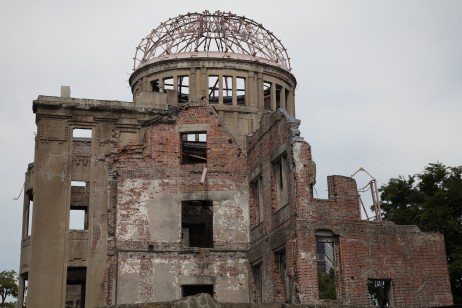 But it was really for the Hall of Remembrance that we came. We took the tram to the Atomic Dome, which is the only skeletal remain of what the city was in the wake of the bomb. It’s still standing by the river, almost exactly below the center of the blast. We moved past the Sadako memorial where we saw Japanese children praying and offering their own 1000 cranes, then all having picnic lunches in the park. We bowed our heads in our own silent prayer as we stood at the shrine at the Cenotaph. Then, inside, we made our way down the spiral ramp in the Hall of Remembrance to the center hall.
But it was really for the Hall of Remembrance that we came. We took the tram to the Atomic Dome, which is the only skeletal remain of what the city was in the wake of the bomb. It’s still standing by the river, almost exactly below the center of the blast. We moved past the Sadako memorial where we saw Japanese children praying and offering their own 1000 cranes, then all having picnic lunches in the park. We bowed our heads in our own silent prayer as we stood at the shrine at the Cenotaph. Then, inside, we made our way down the spiral ramp in the Hall of Remembrance to the center hall.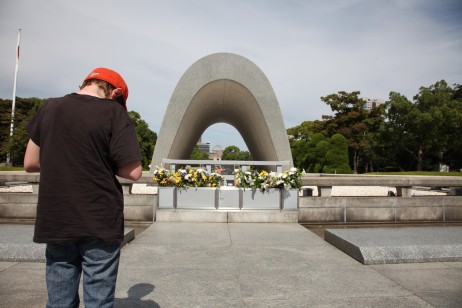 As you make your way down the ramp you stop at six points, each memorializing moments in Hiroshima’s history before and after the bomb. They talk about how Japan came into the war, about how many died, about the radiation sickness and its effects, and about how the war ended. And then you find your way to a circular room with a picture of all the destruction of that day all around you.
As you make your way down the ramp you stop at six points, each memorializing moments in Hiroshima’s history before and after the bomb. They talk about how Japan came into the war, about how many died, about the radiation sickness and its effects, and about how the war ended. And then you find your way to a circular room with a picture of all the destruction of that day all around you.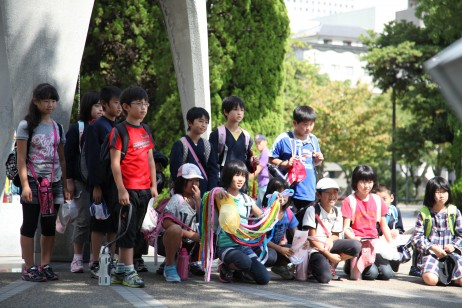 The round hall seemed like a temple. A spare, sacred, simple space. Absolutely peaceful with only a small fountain in the middle and a trickle of water. It was also profoundly sad. We had read “Hiroshima” by John Hersey a few days before and had read some aloud to the kids. What the people of Hiroshima lived through that day and the subsequent days is unimaginable — what they witnessed, the loved ones survivors had to leave behind in collapsed and burning buildings, its absolute horror beyond comprehension.
The round hall seemed like a temple. A spare, sacred, simple space. Absolutely peaceful with only a small fountain in the middle and a trickle of water. It was also profoundly sad. We had read “Hiroshima” by John Hersey a few days before and had read some aloud to the kids. What the people of Hiroshima lived through that day and the subsequent days is unimaginable — what they witnessed, the loved ones survivors had to leave behind in collapsed and burning buildings, its absolute horror beyond comprehension.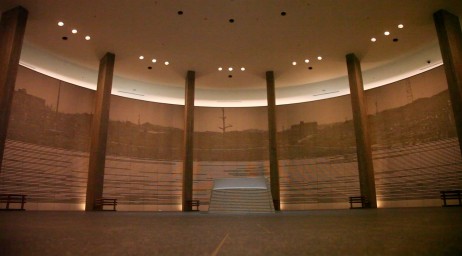 And yet the Hall of Remembrance is absolutely peaceful. Because that is what you feel at Hiroshima. A wish for peace. Nowhere in the world is there a more tangible plea for rationality and world peace. There is not a hint of vitriol or blame for what occurred there. Just acceptance and hope for a better more peaceful world. It was humbling and affecting. We took our moment in that space, to think of our past year and the year ahead, to think of how we could do better, to think about the horrible destructive power of war, and to make our own prayer for peace. This is about as close as our very secular family comes to a religious experience. And at Hiroshima, the religious experience was a powerful one.
And yet the Hall of Remembrance is absolutely peaceful. Because that is what you feel at Hiroshima. A wish for peace. Nowhere in the world is there a more tangible plea for rationality and world peace. There is not a hint of vitriol or blame for what occurred there. Just acceptance and hope for a better more peaceful world. It was humbling and affecting. We took our moment in that space, to think of our past year and the year ahead, to think of how we could do better, to think about the horrible destructive power of war, and to make our own prayer for peace. This is about as close as our very secular family comes to a religious experience. And at Hiroshima, the religious experience was a powerful one.

Touching. Thank you. Makes me think.
Beautiful.
Good luck tomorrow.
absoulutly wonderful!
Thank you very much for your beautiful remembrance and somber and important words. Did you remember the children’s book about Sadako and the 1000 paper cranes? AGain, thanks for the beautiful posting.love,Wendy
Thank you for this
And we are in Prague having just spent six days in Berlin. Same war, different venue. Frankly, I am still sorting it out. Is it wrong I felt such satisfaction that Allied planes flattened Berlin to a rubble – except for peculiar exceptions, like the huge building of Goering’s Luftwaffe HQ, and also this giant airplane mfg plant, the largest military complex in the world besides the Pentagon, this one in the shape of an eagle, Germany’s symbol?
Friday, perhaps, we will go into the countryside and visit a concentration camp. Got to, right?
Silenzio surviving it all. Love,
very moving. I am brimming with tears.
Thank you for telling us about it. It’s very moving and sad and powerful all at once. I wish all the world leaders could see it and learn what you learned.
What a great decision to visit Hiroshima for longer. A wonderful place with a power that must be experienced. Did you managed to find Ground Zero? Not what is expected at all!